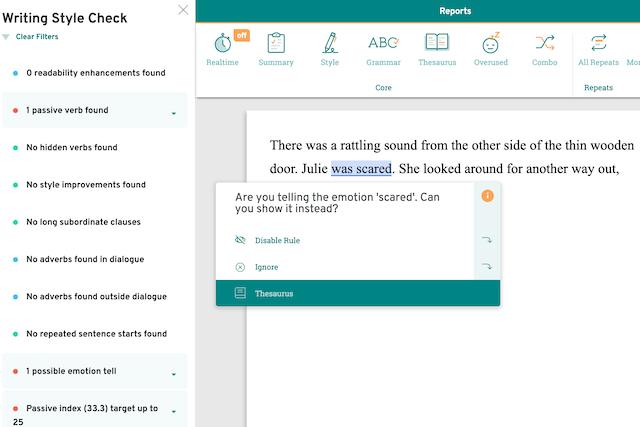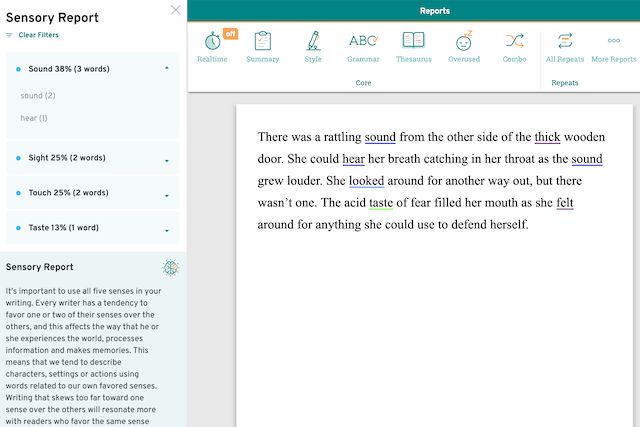
When writing fiction, we want our readers to feel like they’re actually there in the scene. We try our best to bring our writing to life on the page. The best way to do that is with sensory detail.
Unfortunately, this can be one of the hardest writing skills to master.
We’ve all heard the advice, “show, don’t tell,” so many times, but it’s easier said than done.
Showing involves evoking the senses in order to evoke emotion. If this is something you’ve struggled with, fear not! There are some easy ways to improve your sensory writing.
Writing Exercises to Boost Sensory Detail
Like any skill, writing is something that takes practice. No matter how experienced an author you are, don’t discount the power of good, old-fashioned writing exercises. They might have nothing to do with your story at all, and that’s okay! In fact, it’s even better because it forces you to consider new viewpoints.
Here are four of my favorite writing exercises that will help you improve your use of sensory detail.
1. Ekphrastic Writing
Ekphrastic poetry is a type of poetry that vividly describes a scene, specifically from a work of art. It’s about more than just saying what is on the canvas. You are attempting to put into words how the visual artist wanted their viewers to feel about the art.
Not a poet? That’s fine! Write your ekphrasis as a short piece of prose.
2. Describe a Mundane Object
Author Michelle Monárrez is a master of sensory detail, and I asked her to share her secret. She told me in her creative writing program, she spent three hours in class describing a can of Campbell’s soup. That was the professor’s activity for the day. Michelle then taught a group of writers a workshop where we had to describe really mundane objects as vividly as possible.
Go into your pantry and grab a can. Or find any other everyday object that you’ve never thought to describe. Then write about it. Push yourself to explore as many senses as you can.
3. Alternating Viewpoints
Pick a character from your work or any fictional character you can think of. Then try to describe them from the views of someone who loves them, someone who hates them, and someone who just met them. How are these descriptions different? What feelings can your word choice evoke? You can also do this activity with settings or events from your story.
4. “Password” Descriptions
Do you remember the old game show, Password? It’s similar to the games Taboo and Catch Phrase. You have to get someone to guess a word or phrase without saying that word or phrase! In Taboo, there are extra words you cannot say.
This idea makes for a great writing exercise. Describe a storm without using the words “storm” or “rain.” Describe the winter without using “cold.” Describe the physical appearance of a character without stating outright their height, hair color, eye color, or age.
Editing for Sensory Detail
Writing exercises can be helpful and fun, but you also need to apply those skills to your actual writing. Eventually, you’ll get better at including sensory detail in your early drafts, but you can also edit to improve your “showing.”
Here are four ways to edit with sensory detail in mind.
1. Make Verbs Your Friend
Verbs are the most powerful way to show instead of tell. Adjectives are handy, but too many can read like a laundry list. Adverbs won’t create a picture in your readers’ minds like verbs can.
Consider this example. “He walked away sadly.” What does that look like? Is he crying? How do we know he’s sad?
Now replace it with this: “He dropped his shoulders and shuffled his feet, keeping his eyes fixed on the ground.” We can see exactly what the character is feeling.
Find the adverbs in your work and try to replace as many as possible with powerful verbs. ProWritingAid’s Style Report is a good way to find your adverbs.
2. Eliminate Distancing Language
Distancing language is exactly what it sounds like: phrasing that puts distance between your characters (and, by proxy, your readers) and the scene. You might also know them as filter words. Here are examples of some phrases to keep an eye on when you’re revising.
- He felt
- They saw
- We heard
- I think
- She wondered
Sometimes filter words are necessary to the tone of the statement or scene. However, overusing them detracts from the sensory detail because it separates the reader from what is happening. Often, distancing language can simply be removed and the rest of the sentence left intact. Sometimes, though, you may need to replace distancing, “showing” language with more vivid descriptions.
You can find these areas quickly using ProWritingAid’s Emotion Tells check in the Style Report.

The report will highlight words like scared or happy to help you work out where you need to add more detail. You’ll also see where you've used passive voice, which can also be distancing.
So, you’ve found your distancing language, and you need to replace it. How can you do this?
3. Use the Five Senses
Obviously, sensory detail involves the senses. The easiest way to bring your descriptions to life is to include all or most of the five senses. (Sometimes smell and taste just don’t fit the scene, and that’s okay.)
ProWritingAid can come in handy here, too! Under “More Reports,” you can find the Sensory Report. It analyzes your word choice and tells you how many of each sense is present. This gives you a clear idea of what senses you need to add to improve the descriptions.

Every writer has a tendency to favor one or two of their senses over the others, and this affects the way that he or she experiences the world, processes information and makes memories. This means that we tend to describe characters, settings or actions using words related to our own favored senses. Writing that skews too far toward one sense over the others will resonate more with readers who favor the same sense and less so with those who do not.
4. Include Internal Sensations
Most writers can evoke the senses to a degree with external sensations. It’s easier to describe what your characters see and hear and even feel. But internal sensations are just as important and can add greater emphasis and evoke stronger emotions in your readers.
My favorite resource for this is The Emotion Thesaurus by Angela Ackerman and Becca Puglisi. They list common internal sensations for tons of different emotions. These might include heart racing, sweating, nausea, a tight throat, and more. You can ask yourself what emotion your character is experiencing then figure out what that feels like in the body.
Final Thoughts
Sensory detail and showing are some of the most important skills to master. They allow our readers to experience what we can so vividly see and feel in our minds. But it is a skill, not an innate trait. You can learn to improve your sensory writing.
What author do you think has amazing sensory detail? Let us know in the comments below.


